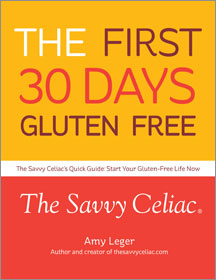From 2000-2009 there have been a lot of changes in the celiac community. So much so, that with us wrapping up this decade in three days, I decided to survey the celiac community to find out what they think the biggest impacts have been to celiac in the last decade….
Starting on December 16th, I opened the survey asking “What do you think has had the greatest impact on the celiac community in the last ten years?” 94 people responded with their top three answers to my survey which closed on December 27th. Monday, we covered the 3rd and 2nd choice answers:
3rd Choice: More gluten-free selection at restaurants
2nd Choice (tie): Celebrity exposure and celiac-related blogging/social networking
Here it is your top choice – for the one thing that’s had the biggest impact on the celiac community:
#1 Medical Research:
48% of respondents picked medical research as their top choice in this survey. Many of them admitted without this, the other exciting developments in the celiac community likely wouldn’t have happened.
One respondent said, “ The greater level of awareness about [celiac disease] in the medical community (which I believe was a result of Dr. [Alessio] Fasano’s study [from the University of Maryland’s Center for Celiac Research] that showed the actual incidence of celiac was 1 in 133 not one in 5000 as previously taught to doctors…) has made a huge difference.” Another respondent agreed, saying the research, “…put us on the map!” The respondent continued saying, “It was then recognized that the disease is common enough to warrant much more attention! From that push came more and better food choices, more people getting diagnosed and more awareness in general. We can never thank Dr. Fasano enough for all that he has done to benefit the celiac community.”
Another person chronicled the timeline of what they thought happened this decade, “…it is really the awareness that stemmed from [Dr. Fasano’s] research that made the food industries and restaurants more helpful. That yielded the avalanche in blogs in social networking and made public personalities come forward.”
I completely agree with all of the above statements. I think without any of the research that is constantly happening we wouldn’t have made the progress we currently have. The 2003 study led by Dr. Fasano at the University of Maryland’s Center for Celiac Research, was the biggest thing to happen to celiac disease at that point. The respondent above is accurate in saying that up until that point they thought the number was more like 1 in 5,000 (I even read somewhere an even bigger number like 1 in 7,000). The University of Maryland says this research “indicates that celiac disease is twice as common as Crohn’s disease, ulceric colitis and cystic fibrosis combined.” This study received national media attention. That study, to this day, still seems to be the standard that all resources use when talking about the prevalence of celiac in the United States.
Another significant study is the Mayo Clinic’s study from last July. This study made it number 2 on my top 5 celiac-related items of 2009. It also received a lot of attention and really reminded people about celiac disease. There is ongoing research that’s happening at many other medical facilities in this country and around the world. I have written about new findings in medical research nearly 30 times just in 2009. So we are very thankful for all of that work and the work that’s yet to be done.
The last 10 years have moved us so far forward and we look ahead to what the future holds for the next decade.
Honorable Mentions…
Food allergen labeling act and online medical research sites are two categories that deserve a nod. These both scored high, but never high enough to make the top three. The Food Allergen Labeling and Consumer Protection Act of 2004 was a significant hurdle for most people with food allergies or sensitivities. FALCPA requires that the top food allergens: milk, eggs, fish, Crustacean shellfish, tree nuts, peanuts, wheat, and soybeans be listed on ingredient labels. For us gluten-free people, wheat was often an ingredient hidden inside “natural flavors”. Now it’s loud and proud on the label which has really helped us…but to a point. It doesn’t include barley or rye. So some ingredients like caramel color could still have hidden gluten. The bill was supposed to enact voluntary gluten-free labeling in 2008. That has yet to happen. Overall, the bill has helped in forcing companies to reveal more about the ingredients they’re putting in the food they’re producing.
Online medical or research sites has really boomed. I felt this category HAD to be separate from the blogging/social networking option because the medical/research sites usually have more reliable information. I use these websites to source my blog posts all the time for that very reason. Back when Emma was diagnosed in 2000, and I worked in TV News, we were constantly writing stories about how inaccurate medical information was on the internet. That has definitely changed. Now with sites like the University of Maryland’s, University of Chicago, Mayo Clinic, Celiac.com, and advocacy groups like National Foundation for Celiac Awareness and the American Celiac Disease Alliance there are many reliable sources available for gaining information on celiac disease.
One final thought on support groups. I bet if this same survey would have been done in the 1990s, support groups would have been ranked in the top three. But I believe with the internet, email, and social networking, the support group members go to the computer first instead of waiting to ask their questions at a monthly face-to-face meeting. But we need to give that area credit for helping so many people through difficult times…
Now it’s time to look forward to the next decade and the excitement that it brings! Find out what people are hoping to see happen with celiac disease from 2010-2019 – next Monday.
Tags: celiac, decade, event, impact, list, medical, research, survey, top



2 Responses to “Top impact on celiac community in the last decade is…”
Trackbacks/Pingbacks
Leave a Reply